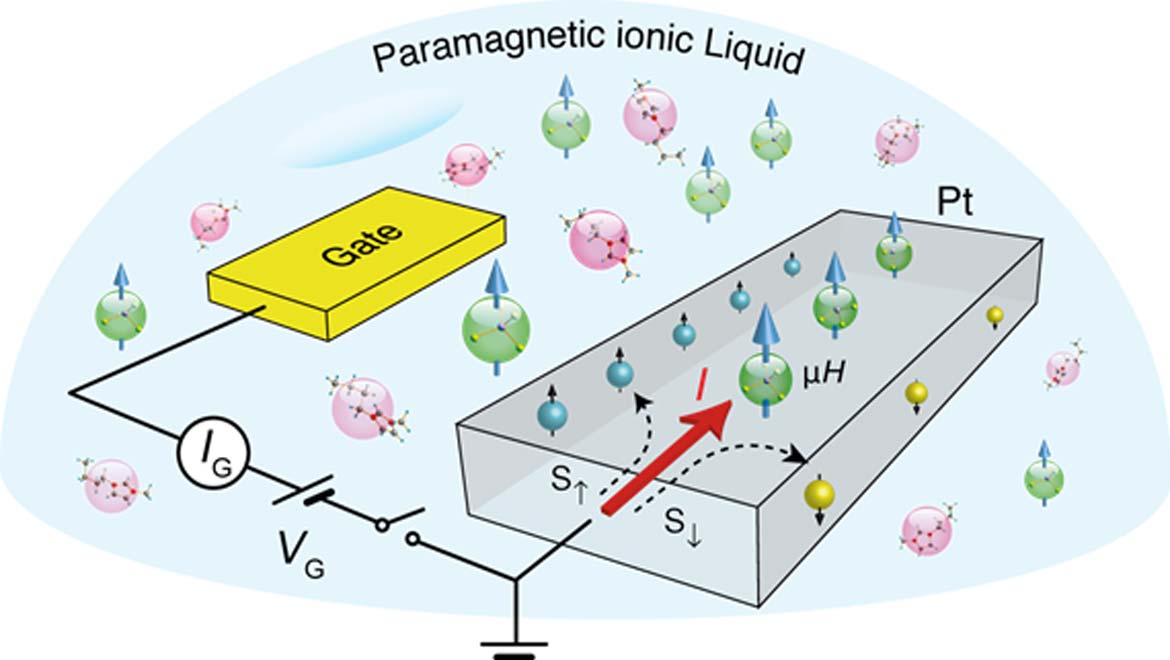Platinum is a mid-table, stable, white metal prized for its use in jewelry and electronics. The metal has excellent conductive properties in addition to its good looks.
However, the metal does not have other beneficial properties, thus limiting its use and value. For example, no form of platinum has ever been magnetic...that is, until now.
A team of scientists from the University of Groningen has reported the successful creation of a two-dimensional magnet made of the precious metal, platinum. The magnet can also be turned 'on' and 'off' using electricity. This switch-ability could be very valuable to manufacturers of the next generation of electronics.
New Developments for New Magnets
The team, led by Justin T. Ye from the University's Device Physics of Complex Materials group, produced magnetism in a thin layer of platinum through its immersion in butylmethylimidazolium tetrachloroferrate (BMIM[FeCl4]).
The paramagnetic ionic fluid completed a transistor by acting as a medium between a gold electrode and the platinum film as a channel. This setup conferred ferromagnetism on the platinum, in the presence of an electric field.
The researchers developed the liquid BMIM[FeCl4] themselves, in response to their estimations of what was required to procure magnetic 2D platinum.
Such a liquid would need to contain anions with particular orbital properties. The positively (Fe(III)) charged iron in the FeCl4 met this need. It had an unpaired spin in all five of its 3d electron-orbits, giving a total quantum number of 5/2.
BMIM[FeCl4] was also stable at room temperature and had an extensive electrochemical window. In addition, the compound had a relatively large magnetic moment equivalent to 5.87μB.
Magnetization in Thin-Layer Platinum
All these properties resulted in a uniform movement of the cations across the surface of the platinum, under the effect of positive gate voltage.
The Groningen team also reported that the magnetism of their films in the BMIM[FeCl4]-mediated setups appeared to decrease with the depth of the film. This event was thought to be related to the anomalous Hall effect. This effect can be defined as the phenomenon in which the resistivity within the transistor is affected by the magnetization, magnetic field and the Hall coefficients (both normal and abnormal).
The team reported that magnetization was greater in a thinner film. For example, the magnetization in a film 2.7nm thick was one order of magnitude more magnetized compared to a second film 8nm in thickness.

Lei Liang, the first author of the Science Advances paper written on the platinum magnet. (Source: L. Liang)
These properties, along with the others that helped the platinum films confine their magnetism to the surfaces, meant that the metal's ferromagnetism matched the theoretical ideal for such a concept.
This magnetism also persisted (albeit variable) at a range of temperatures, which the team put down to the presence of the BMIM[FeCl4] medium.
In contrast, certain prototype thin-layer ferromagnets using other materials are only functional at lower temperatures. This new, platinum-based example can function at room temperature, which increases its potential applications in future devices.
Platinum Ferromagnets and Spintronics
Ye's research team also believes that their innovative ferromagnet can be useful in the emerging field of spintronics. In this variation on electronics, the magnetic moment (which is based on electron spin properties) can control the transfer of data.
The platinum ferromagnet can also be used to control charge, which makes it even more amenable to spintronic applications. Additionally, the paramagnetic fluid allows greater control over the number of carriers available across the magnet.
Other experts have attempted to develop magnets that satisfy the needs of spintronic applications. However, those prototypes have taken different conformations, such as multiple layers of magnetic materials, where spin currents arise to drive magnetizations.
However, the Groningen team's uni-layer solution is simpler and can, therefore, be more attractive to those interested in this potential field of electronics.
Conclusion
Platinum is a metal that, unlike others such as copper and nickel, is on the cutting-edge of ferromagnetic properties, in theory.
A team of researchers working at a Dutch university have developed a compatible paramagnetic liquid, as a gating medium, that transforms nanometric layers of the metal into a magnet. It does this in the presence of an electric field.
The new invention can potentially be used in electronics that also transfer data via electron spin (which constitutes magnetic moment) as well as charge-switching. In other words, this world-first demonstration of magnetic platinum may end up informing the future of computing.
Top Image: Transistor with a 2D platinum (Pt) channel as a magnet. Pink bubbles: cations; green bubbles: anions. (Source: L. Liang)
References
L. Liang, et al. (2018) Inducing ferromagnetism and Kondo effect in platinum by paramagnetic ionic gating. Science Advances. 4:(4).
S.-h. C. Baek, et al. (2018) Spin currents and spin–orbit torques in ferromagnetic trilayers. Nature Materials.
R. Stosser, et al. (2013) Physical and chemical response of FeCl3/FeCl4(-) spin probes on the functionalizing of ionic liquids. J Phys Chem A. 117:(19). pp.3960-3971.







No comment